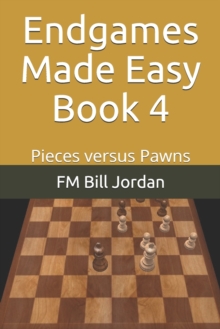
Endgames Made Easy Book 2 : Lone King Endgames Paperback / softback
by Fm Bill Jordan
Part of the Endgames Made Easy series
Paperback / softback
Description
Introduction
The largest difference in strength between the amateur and master is in the endgame. Its my observation after many years of playing and coaching that average club players typically have major gaps in their basic endgame knowledge.To play endgames strongly you do not need to know thousands of positions. A good understanding of basic principles, knowledge of some key positions and the ability to calculate well will go a long way.
The book draws from many endgame examples that FIDE Master Bill Jordan has used in years of chess coaching.
Some players make an interesting point, why study the ending if I don't get many? Well, there is lots of reasons. The number of endings will increase as general playing strength increases. This is because players increase their ability to survive middlegames. The number of endgames will also increase if playing more evenly matched opponents. If neither player makes tactical mistakes, then an endgame is very likely.
Even if you don't have an ending, endgame study may create ideas useful for the middlegame, especially positional ideas. Because you have so few pieces, placement of the pieces becomes all that more important.
More importantly, you will know what endings to aim for. In many games between good players, one or both players has had option to exchange into ending at some point. If your ending understanding is weak, how will you know when to exchange and when not to?
Playing for an ending, is sometimes the best way to exploit a positional advantage in pawn structure. With fewer pieces on, active piece play is less likely to compensate for weak squares and weak pawns.
Endgames Made Easy
This is Book 2 of a set of 5.The complete set of Endgames Made Easy is:- Basic Concepts
- Lone King Endgames
- Pawn Endgames
- Pieces versus Pawns
- Piece Endgames
Lone King Endgames
Lone King endgames are endgames in which one side only has a King. Some are instant draws. Some are draws with best play while others are a win for the stronger side with best play.King versus King, Knight versus King or Bishop versus King is an instant draw. No checkmate is possible.
Rook versus King or Queen versus King is a win with best play.
Two bishops versus King is a win with best play.
Knight and Bishop versus King is a win with best play.
Two knights versus King is a draw with best play.
One or more pawns versus King is sometimes a draw with best play, sometimes a win.
Minor piece (knight or bishop) plus pawn is sometimes a draw with best play, sometimes a win.
Checkmate a lone King, drive it to the edge, or better still, the corner. Be careful not to stalemate. Your pieces need to work as a team, endless checks will get you nowhere.
When attempting to queen a pawn, use your pieces to help the pawn by controlling the path of the pawn.
This book has many large clear diagrams. You do not need a chess set and board to read this book. It is designed to be read several times.
Information
-
Only a few left - usually despatched within 24 hours
- Format:Paperback / softback
- Pages:100 pages
- Publisher:Independently Published
- Publication Date:24/10/2018
- Category:
- ISBN:9781728777580
Information
-
Only a few left - usually despatched within 24 hours
- Format:Paperback / softback
- Pages:100 pages
- Publisher:Independently Published
- Publication Date:24/10/2018
- Category:
- ISBN:9781728777580










